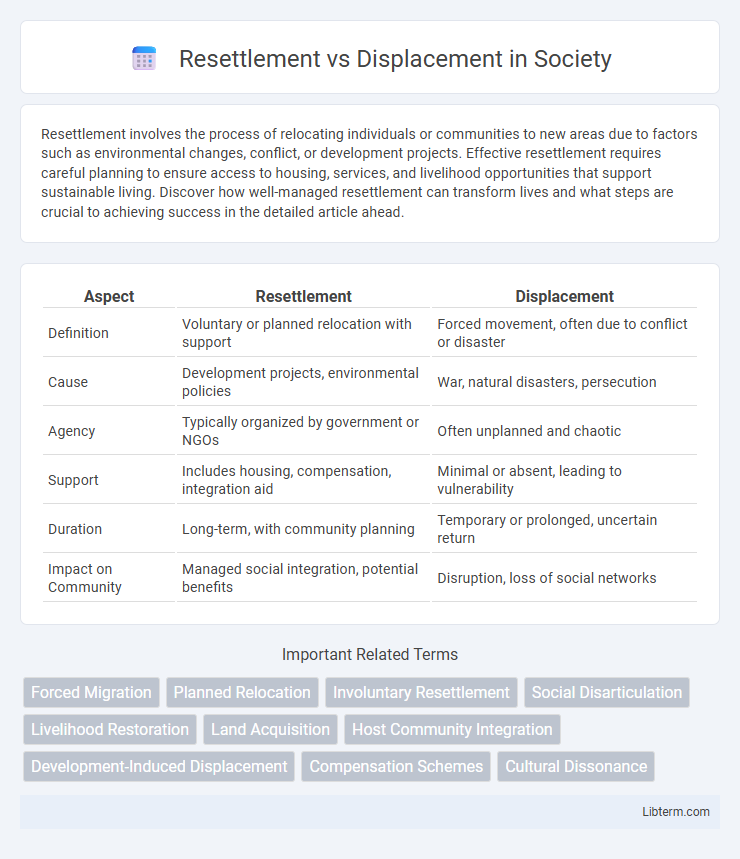Resettlement involves the process of relocating individuals or communities to new areas due to factors such as environmental changes, conflict, or development projects. Effective resettlement requires careful planning to ensure access to housing, services, and livelihood opportunities that support sustainable living. Discover how well-managed resettlement can transform lives and what steps are crucial to achieving success in the detailed article ahead.
Table of Comparison
| Aspect | Resettlement | Displacement |
|---|---|---|
| Definition | Voluntary or planned relocation with support | Forced movement, often due to conflict or disaster |
| Cause | Development projects, environmental policies | War, natural disasters, persecution |
| Agency | Typically organized by government or NGOs | Often unplanned and chaotic |
| Support | Includes housing, compensation, integration aid | Minimal or absent, leading to vulnerability |
| Duration | Long-term, with community planning | Temporary or prolonged, uncertain return |
| Impact on Community | Managed social integration, potential benefits | Disruption, loss of social networks |
Understanding Resettlement and Displacement
Resettlement involves the planned relocation of communities, often by governments or organizations, to new areas with the goal of improving living conditions or managing development projects. Displacement refers to the involuntary movement of people due to conflict, natural disasters, or development activities, often resulting in loss of homes and livelihoods without adequate support. Understanding these concepts is crucial for designing policies that protect the rights and well-being of affected populations.
Key Differences Between Resettlement and Displacement
Resettlement involves the planned relocation of individuals or communities with support and resources to improve their living conditions, whereas displacement is often forced and involuntary due to conflict, natural disasters, or development projects, causing abrupt loss of homes and livelihoods. Key differences include resettlement's focus on long-term rehabilitation and consent versus displacement's sudden disruption and lack of agency for affected people. Furthermore, resettlement programs aim for sustainable integration and social stability, while displacement typically results in humanitarian crises and increased vulnerability.
Causes of Displacement: A Global Perspective
Conflict, natural disasters, and economic instability are primary causes of displacement worldwide, forcing millions to leave their homes annually. Climate change-induced events such as floods, droughts, and hurricanes increasingly contribute to large-scale forced migration. Political persecution and development projects also drive displacement, prompting varying responses like resettlement programs to provide sustainable solutions for affected populations.
The Process of Resettlement: Steps and Challenges
The process of resettlement involves several critical steps, including identification of affected populations, community consultation, planning and provisioning of housing, infrastructure, and social services, followed by monitoring and evaluation to ensure sustainable outcomes. Key challenges in resettlement include securing adequate funding, addressing legal and land tenure issues, mitigating socio-economic disruptions, and fostering community acceptance to prevent long-term marginalization. Effective resettlement requires coordinated efforts between governments, non-governmental organizations, and affected communities to balance development goals with human rights protection.
Social and Economic Impacts on Affected Populations
Resettlement often causes significant disruptions to social networks and economic activities, leading to loss of community cohesion and livelihoods among affected populations. Displacement typically results in immediate deprivation of housing, employment, and access to essential services, exacerbating poverty and social instability. Both phenomena necessitate comprehensive support strategies to mitigate long-term impacts on social integration and economic resilience.
Legal Frameworks Governing Resettlement and Displacement
Legal frameworks governing resettlement and displacement are primarily rooted in international human rights laws such as the Guiding Principles on Internal Displacement and the UN Refugee Convention. National legislation often complements these frameworks by defining procedures for lawful resettlement, compensation, and protection measures for displaced persons. Effective legal governance ensures the protection of affected populations' rights, including access to adequate housing, livelihood restoration, and participation in resettlement planning processes.
Human Rights Concerns in Displacement and Resettlement
Displacement often violates fundamental human rights such as the right to adequate housing, freedom of movement, and access to livelihood, leading to increased vulnerability and social disintegration. Resettlement programs frequently fail to provide proper compensation, participation in decision-making, and access to essential services, exacerbating economic and psychological hardships for displaced communities. Ensuring human rights compliance in displacement and resettlement requires robust legal frameworks, transparent processes, and active involvement of affected populations to uphold dignity and prevent marginalization.
Role of Government and NGOs in Resettlement Programs
Governments play a pivotal role in resettlement programs by formulating policies, allocating resources, and ensuring legal frameworks support affected populations' rights and access to essential services. NGOs complement government efforts through community engagement, providing humanitarian aid, capacity building, and monitoring resettlement outcomes to promote social integration and sustainable livelihoods. Collaboration between government agencies and NGOs enhances the effectiveness of resettlement initiatives by addressing both infrastructural and socio-economic challenges faced by displaced communities.
Success Stories and Lessons Learned from Real Cases
Resettlement initiatives in regions like Bangladesh and Uganda have demonstrated success through community participation and sustainable livelihood programs, significantly improving social integration and economic stability for displaced populations. Displacement cases, such as those in Syria and South Sudan, underscore the critical need for timely humanitarian aid and coordinated international response to mitigate long-term vulnerability and cultural erosion. Lessons learned emphasize the importance of inclusive planning, local stakeholder engagement, and adaptive support mechanisms to enhance resilience and ensure more effective outcomes in both resettlement and displacement contexts.
Future Directions: Sustainable Solutions for Displaced Communities
Future directions in addressing resettlement versus displacement emphasize sustainable solutions that prioritize long-term community resilience and social integration. Strategies include enhancing local infrastructure, promoting economic opportunities through skill development, and ensuring participatory decision-making in resettlement planning. Leveraging technology, climate adaptation measures, and inclusive policies can significantly improve the quality of life for displaced populations while minimizing environmental and social impacts.
Resettlement Infographic

 libterm.com
libterm.com